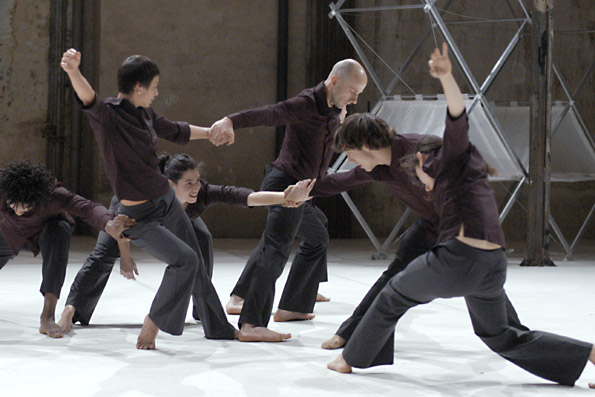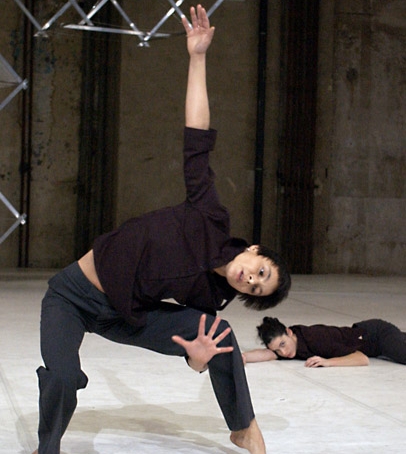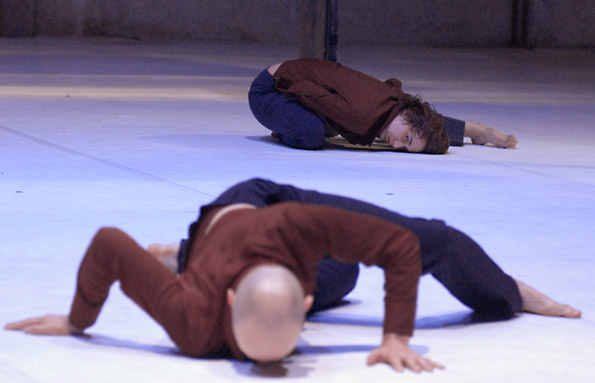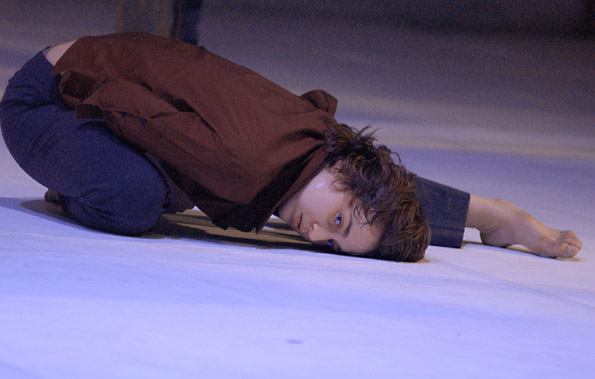Homo Sacer
2004, 7 Dancers, 60 Min., 14 x 12 Meter
about the piece
In „Sovereign Power and Bare Existence“ by the Italian philosopher Giorgio Agamben, homo sacer, an obscure figure of archaic roman law, becomes a cipher – an exemplary model for a discussion of the paradoxes of bio-politics. He primarily rediscovers homini sacri in the refugee camps of past and current history. The figure of homo sacer that Agamben brings into the discourse is an apocalyptical image, one that has already long since begun to take on a life of its own. Christoph Winkler takes this image and all its many implications and re-attributes the discourse back to dance in a combination of documentary material and movements.
videos
Homo Sacer - Arte France, La maison de la dance de Lyon et les Films pénélope
credits
Choreography: Christoph Winkler | Dance: Florian Bilbao, Lydia Klement, Miriam Kohler, Ricardo Angelo de Paula, Anna-Luise Recke, Yael Schnell, Günther Wilhelm | Stage design: Alexander Schellow | Music: Ekkehard Ehlers | Light: André Schulz | Production management: Barbara Friedrich
A Christoph Winkler production in cooperation with Sophiensæle and the production office TANZTAGE BERLIN. Made possible by the Hauptstadtkulturfonds. Supported by Fonds Darstellende Künst
reviews
Unbelievable: Dance can be political. The choreographer Christoph Winkler has given us proof of this in his dance piece “Homo Sacer” in the Sophiensaele… - Neues Deutschland
Christoph Winkler isn’t the type whose work is illustrative, thank God. He never claims that movement has meaning, on the contrary…During the ensuing sixty minutes, the choreography develops into an impressive interwoven web; how combinations, chains of bodies and groups develop, condensation and seclusion occurs, space is taken and again released. The spoken material runs up against a wall, into a futile situation, leaving us anxious for a continuation of the movement, waiting for that supple gliding. - Die Tageszeitung
The ornamental beauty of the curved line and the perfect form of the circle are the main motifs in Christoph Winkler’s new…dance piece Homo Sacer. They spread from dancer to dancer; roll bundled in waves over the stage… The contrast between the flayed figures and the gracefulness of the movement seems extreme, but could be explained with a nod towards Kleist’s thoughts on the puppet theatre: The most elegant kind of movement is only possible when it is unconscious. - Tagesspiegel
One after another, the other seven dancers climb out of the resting niches. All look distraught in the glaringly lit space, whose angularity contrasts with the fragile bodies. Following abrupt impulses, the dancers break out of themselves, only to quickly fall back into the frozen pose. Humans fleeing and hesitating in the same moment, developing an icy atmosphere of vulnerability … But in the following choreographic sequence, in which the dancers seem to be wrestling with themselves as if the truth were strangling them in its grasp, is a brilliant scene in which the ensemble intertwines and connects into complex structures that, only moments later are again severed. Energy shoots up like suddenly occurring memories – symbolizing the sudden convulsion of that very “base existence”… - Frankfurter Rundschau
The choreographer has truly succeeded in formulating a position that is both an aesthetic and ethical one. Life may be a sacred possession – in the face of sanctioned (war) crimes it becomes a disposable commodity. Dance cannot intervene in this state of affairs. But it can champion life, by displaying it in its vulnerability. Homo Sacer is not only in this respect Winkler’s most impressive piece to date. - tanzjournal










